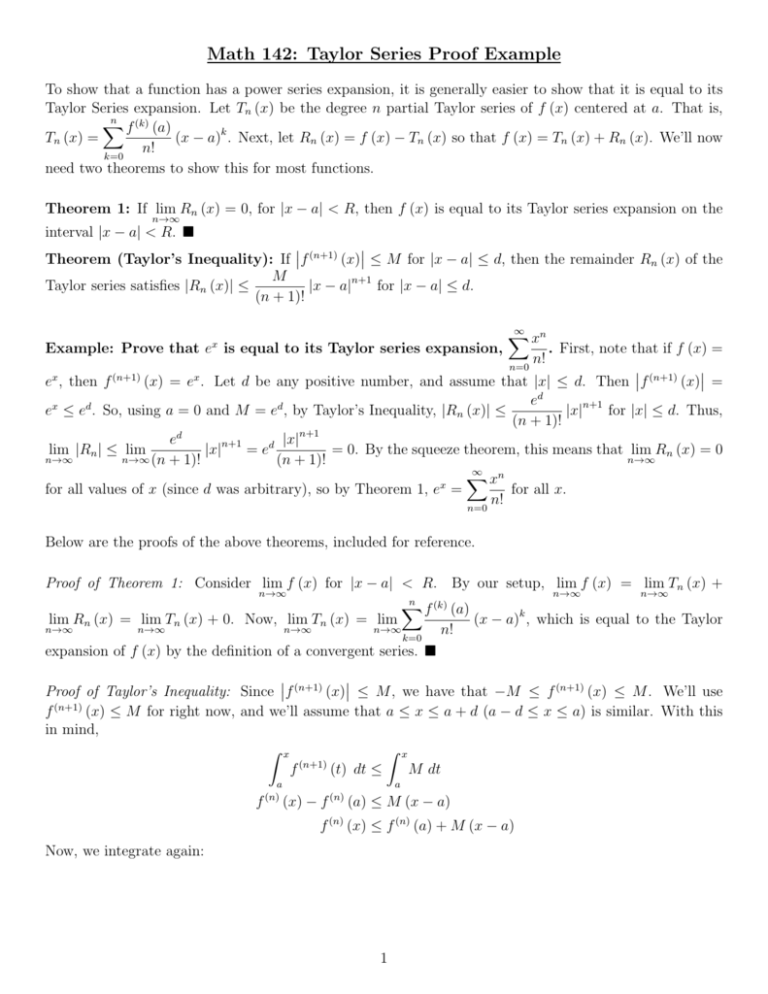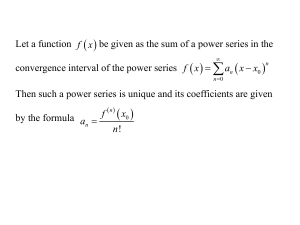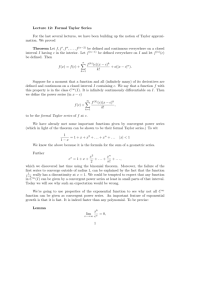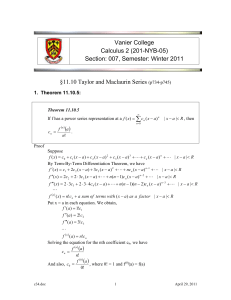Math 142: Taylor Series Proof Example
advertisement

Math 142: Taylor Series Proof Example To show that a function has a power series expansion, it is generally easier to show that it is equal to its Taylor Series expansion. Let Tn (x) be the degree n partial Taylor series of f (x) centered at a. That is, n X f (k) (a) Tn (x) = (x − a)k . Next, let Rn (x) = f (x) − Tn (x) so that f (x) = Tn (x) + Rn (x). We’ll now n! k=0 need two theorems to show this for most functions. Theorem 1: If lim Rn (x) = 0, for |x − a| < R, then f (x) is equal to its Taylor series expansion on the n→∞ interval |x − a| < R. Theorem (Taylor’s Inequality): If f (n+1) (x) ≤ M for |x − a| ≤ d, then the remainder Rn (x) of the M |x − a|n+1 for |x − a| ≤ d. Taylor series satisfies |Rn (x)| ≤ (n + 1)! x Example: Prove that e is equal to its Taylor series expansion, ∞ X xn . First, note that if f (x) = ex , then f (n+1) (x) = ex . Let d be any positive number, and assume that |x| ≤ d. Then f (n+1) (x) = ed |x|n+1 for |x| ≤ d. Thus, ex ≤ ed . So, using a = 0 and M = ed , by Taylor’s Inequality, |Rn (x)| ≤ (n + 1)! ed |x|n+1 lim |Rn | ≤ lim |x|n+1 = ed = 0. By the squeeze theorem, this means that lim Rn (x) = 0 n→∞ n→∞ (n + 1)! n→∞ (n + 1)! ∞ n X x for all x. for all values of x (since d was arbitrary), so by Theorem 1, ex = n! n=0 n=0 n! Below are the proofs of the above theorems, included for reference. Proof of Theorem 1: Consider lim f (x) for |x − a| < R. By our setup, lim f (x) = lim Tn (x) + n→∞ n→∞ n→∞ n (k) X f (a) lim Rn (x) = lim Tn (x) + 0. Now, lim Tn (x) = lim (x − a)k , which is equal to the Taylor n→∞ n→∞ n→∞ n→∞ n! k=0 expansion of f (x) by the definition of a convergent series. Proof of Taylor’s Inequality: Since f (n+1) (x) ≤ M , we have that −M ≤ f (n+1) (x) ≤ M . We’ll use f (n+1) (x) ≤ M for right now, and we’ll assume that a ≤ x ≤ a + d (a − d ≤ x ≤ a) is similar. With this in mind, Z x Z x (n+1) f (t) dt ≤ M dt a a f (n) (x) − f (n) (a) ≤ M (x − a) f (n) (x) ≤ f (n) (a) + M (x − a) Now, we integrate again: 1 Z x f (n) a Z x (t) dt ≤ f (n) (a) + M (x − a) dt a f (n−1) (x) − f (n−1) (a) ≤ f (n) (a) (x − a) + M (x − a)2 2 f (n−1) (x) ≤ f (n−1) (a) + f (n) (a) (x − a) + M (x − a)2 2 Continuing this process, we have: (x − a)2 (x − a)3 f (x) ≤ f (a) + f (a) (x − a) + f (a) +M 2 3! 2 (x − a)3 (x − a)4 (x − a) (n) (n−3) (n−3) (n−2) (n−1) + f (a) +M f (x) ≤ f (a) + f (a) (x − a) + f (a) 2 3! 4! .. . (n−2) (n−2) (n−1) (n) (x − a)2 (x − a)n−1 (x − a)n + ... + f (n) (a) +M 2 (n − 1)! n! 2 n (x − a) (x − a) (x − a)n+1 0 00 (n) f (x) ≤ f (a) + f (a) (x − a) + f (a) + ... + f (a) +M 2 n! (n + 1)! f 0 (x) ≤ f 0 (a) + f 00 (a) (x − a) + f 000 (a) (x − a)2 (x − a)n (x − a)n+1 − ... − f (n) (a) ≤M , 2 n! (n + 1)! M M which is the same as f (x) − Tn (x) ≤ (x − a)n+1 , and finally, Rn (x) ≤ (x − a)n+1 . By (n + 1)! (n + 1)! −M (x − a)n+1 . Thus, a similar argument, using f (n+1) (x) ≥ −M , we can show that Rn (x) ≤ (n + 1)! M |Rn (x)| ≤ |x − a|n+1 for |x − a| ≤ d. (n + 1)! So, we have that f (x) − f (a) − f 0 (a) (x − a) − f 00 (a) 2










